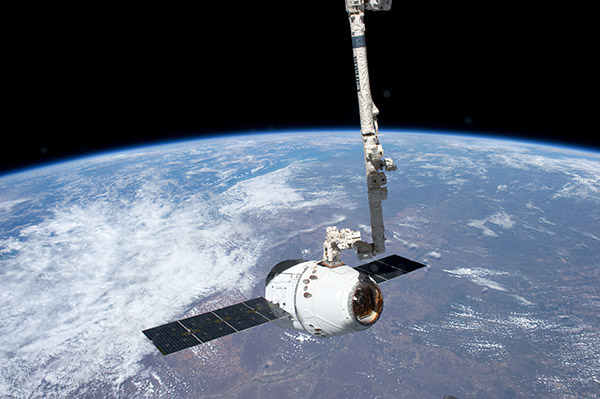
by Ryan Anderson Friday, August 24, 2012

View of the SpaceX Dragon from the International Space Station as the station's robotic arm moves Dragon into place for attachment to the station - thus capturing the 'Dragon by the tail' as astronaut Don Pettit put it. NASA
“Looks like we’ve got us a Dragon by the tail.”
So said astronaut Don Pettit upon the successful capture of the SpaceX Dragon capsule by the robotic arm on the International Space Station (ISS) in May, heralding a revolution in space exploration with a bit of humor. We have entered the era of private spaceflight, and just in time.
NASA still does some great things, but today’s NASA is not the well-funded, nimble and bold agency that sent astronauts to the moon. Today’s NASA is risk-averse and saddled by special interests, an aging workforce and funding levels that shift with the political winds.
Thanks to political gridlock, NASA’s human spaceflight program is struggling along while astronauts catch rides to the ISS on Russian rockets. But the successful Dragon test flight may change that. When the Dragon capsule was recovered from the Pacific, the sensors indicated that if astronauts had been along for the ride, they would have been safe and sound. SpaceX has announced that it intends to fly humans in Dragon by 2015.
And SpaceX, based in California, is not the only game in town. Virginia-based Orbital Sciences plans to launch its own capsule, Cygnus, to the ISS in October, using its Antares rocket.
Of course, there’s more to space exploration than hefting astronauts into low-Earth orbit to study how fast their bones disintegrate. Two other major avenues are being pursued for commercial spaceflight: mining and tourism.
In April, the Seattle-based startup Planetary Resources, bankrolled by a handful of billionaires and led by Peter Diamandis and Eric Anderson, made waves by announcing that it intends to mine asteroids. The company first plans to provide small space telescopes that can be used for both astronomy and asteroid tracking. These will be followed by robotic missions to scout promising near-Earth objects, and eventually by robotic miners that will extract resources such as precious metals (to be used in space and on Earth) and water (which can be used as rocket fuel). The company also intends to develop tools to tweak the orbits of small asteroids, which may come in handy both for mining and for helping Earth avert potentially catastrophic collisions.
Although it sounds like science fiction, asteroid mining makes a lot of sense. Thanks to the small size and weak gravity of most asteroids, getting to a near-Earth asteroid and back is much easier to accomplish than a round-trip to the moon or Mars. Also, metals are easier to extract from asteroids than from Earth rocks. In fact, some asteroids are nothing but metal. There are still many technical challenges, but Planetary Resources has deep-pocketed investors who think the cost to overcome these challenges will pay off in the long run.
Space tourism is also becoming an increasingly plausible business model. Since 2001, seven space tourists have flown aboard Russian rockets to the ISS for $20 million to $35 million apiece.
In 2004, California-based Scaled Composites made history (and won the X-Prize) by flying the first privately funded spacecraft: Spaceship One. The company has now partnered with Virgin Galactic, which is selling flights on Spaceship Two for $200,000 a seat. So far, more than 500 people have signed up, each making a down payment of $20,000. Another California-based company, XCOR, plans to launch its fully reusable suborbital space plane Lynx later this year, and intends to sell seats at $95,000 a pop.
For space tourists not satisfied with only a brief taste of spaceflight (and for more serious space-based research endeavors), Las Vegas-based Bigelow Aerospace has developed expandable space stations to be used as orbiting hotels (or laboratories). Prototypes were launched in 2006 and 2007, and Bigelow Aerospace has reserved a launch on a Falcon 9 rocket in 2014, presumably for its newest orbital habitat.
One of the biggest challenges with all of these endeavors is returning passengers to Earth safely. That’s not a concern for the newly proposed Mars One startup. Founded by Dutch entrepreneur Bas Lansdorp, Mars One has received attention recently after announcing plans to launch a one-way crewed mission to Mars by 2023. Lansdorp plans to fund the mission by making it into a “global media spectacle.” That’s right: The first humans to set foot on the Red Planet might be reality TV stars. You have to admit, the show would be more interesting than yet another season of “Big Brother.”
It’s not clear what spacecraft Mars One would use to get to Mars, but one option is SpaceX’s Red Dragon system, a robotic lander proposed by NASA Ames to launch in 2018 and study astrobiology on Mars. If successful, a similar system might be used to send the first humans to the surface, be they reality TV stars or traditional astronauts.
From ISS resupply and suborbital joyrides, to asteroid mining and missions to Mars, there is no shortage of ideas for the commercialization of space. Will some of these ventures fail? Certainly. But the simple fact that entrepreneurs can announce plans to mine asteroids or build their own space stations and not be laughed out of the room means we have entered a new era of space exploration.
© 2008-2021. All rights reserved. Any copying, redistribution or retransmission of any of the contents of this service without the expressed written permission of the American Geosciences Institute is expressly prohibited. Click here for all copyright requests.